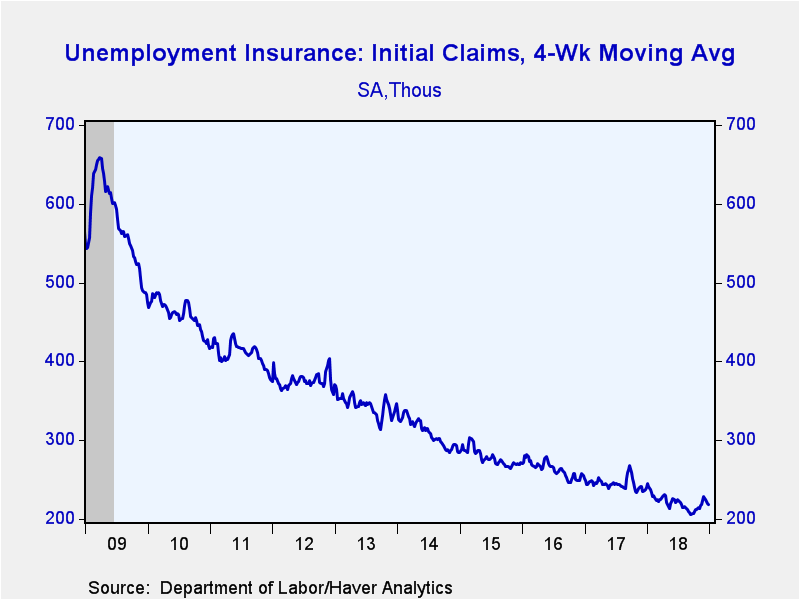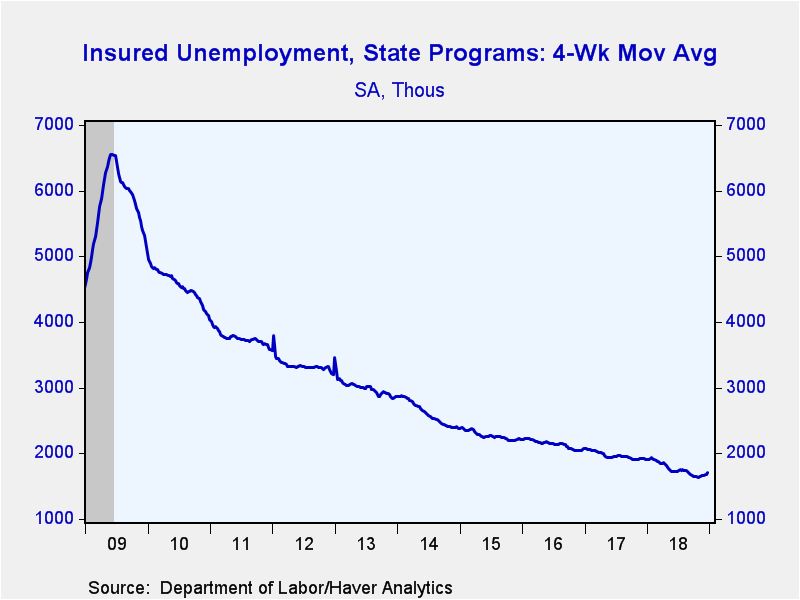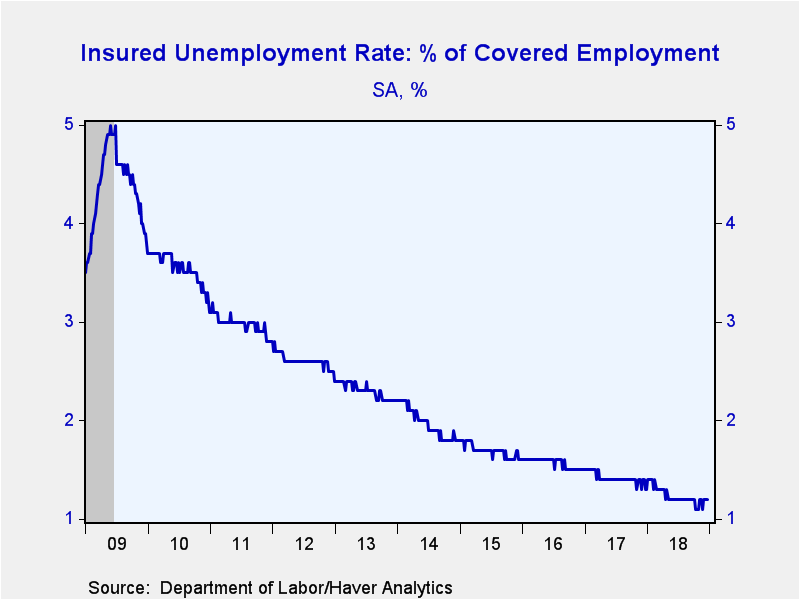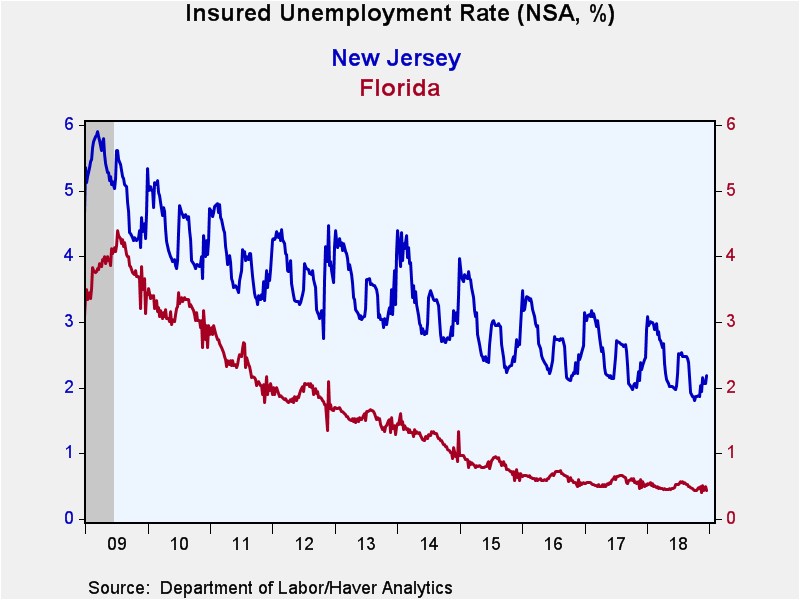 Global| Jan 03 2019
Global| Jan 03 2019U.S. Jobless Claims Jump at Year End
by:Sandy Batten
|in:Economy in Brief
Summary
Initial unemployment insurance claims jumped 10,000 to 231,000 (-6.9% y/y) in the week ended December 29 versus an upwardly revised 221,000 in the previous week. The Action Economics Forecast Survey expectation was for 219,000 new [...]
Initial unemployment insurance claims jumped 10,000 to 231,000 (-6.9% y/y) in the week ended December 29 versus an upwardly revised 221,000 in the previous week. The Action Economics Forecast Survey expectation was for 219,000 new filings. The four-week moving average declined to 218,750 from 219,250. Note that this week included Christmas and so is subject to considerably more statistical noise that usual.
Continuing claims for unemployment insurance rose to 1.740 million (-8.0% y/y) in the week ended December 22 from 1.708 million the previous week. The four-week moving average of continuing claims rose to 1.704 million from 1.678 million, the highest reading since September 1, 2018.
The insured unemployment rate, which compares the number of people receiving benefits to the number of people covered by unemployment insurance, held steady at 1.2% in the week ended December 22, just 0.1%-point above its record low last reached in November.
This report was not directly impacted by the recent and continuing Federal government shutdown, but could have been indirectly impacted by nongovernment employees furloughed as a result of the shutdown filing for state benefits (which were reported for the week ended December 29). Unemployed Federal employees would apply for benefits from Federal programs. The headline figure in this report is claims filed for state programs. Moreover, the Federal programs claims data are reported with a one-week lag. So, the Federal data in today's report are for the week ended December 22, the day the Federal government shut down.
Insured unemployment rates vary widely by state. Currently, Northeast and West Coast states generally have higher unemployment rates, while Southern states have lower rates. During the week ending December 15, the lowest rates were in Florida (0.44%), North Carolina (0.49%), and Tennessee (0.54%). The highest rates were in Alaska (3.27%), New Jersey (2.18%) and California (1.99%). These state data are not seasonally adjusted.
Data on weekly unemployment claims going back to 1967 are contained in Haver's WEEKLY database and are summarized monthly in USECON. Data for individual states are in REGIONW. The expectations figure is from the Action Economics Forecast Survey, carried in the AS1REPNA database.
| Unemployment Insurance (SA, 000s) | 12/29/18 | 12/22/18 | 12/15/18 | Y/Y % | 2017 | 2016 | 2015 |
|---|---|---|---|---|---|---|---|
| Initial Claims | 231 | 221 | 217 | -6.9 | 245 | 263 | 278 |
| Continuing Claims | -- | 1,740 | 1,708 | -8.0 | 1,961 | 2,136 | 2,267 |
| Insured Unemployment Rate (%) | -- | 1.2 | 1.2 |
1.3 |
1.4 | 1.6 | 1.7 |
Sandy Batten
AuthorMore in Author Profile »Sandy Batten has more than 30 years of experience analyzing industrial economies and financial markets and a wide range of experience across the financial services sector, government, and academia. Before joining Haver Analytics, Sandy was a Vice President and Senior Economist at Citibank; Senior Credit Market Analyst at CDC Investment Management, Managing Director at Bear Stearns, and Executive Director at JPMorgan. In 2008, Sandy was named the most accurate US forecaster by the National Association for Business Economics. He is a member of the New York Forecasters Club, NABE, and the American Economic Association. Prior to his time in the financial services sector, Sandy was a Research Officer at the Federal Reserve Bank of St. Louis, Senior Staff Economist on the President’s Council of Economic Advisors, Deputy Assistant Secretary for Economic Policy at the US Treasury, and Economist at the International Monetary Fund. Sandy has taught economics at St. Louis University, Denison University, and Muskingun College. He has published numerous peer-reviewed articles in a wide range of academic publications. He has a B.A. in economics from the University of Richmond and a M.A. and Ph.D. in economics from The Ohio State University.










